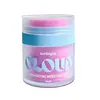What's inside
What's inside
 Key Ingredients
Key Ingredients

 Benefits
Benefits

 Concerns
Concerns

 Ingredients Side-by-side
Ingredients Side-by-side

Propylene Glycol
HumectantCarbomer
Emulsion StabilisingPhenoxyethanol
PreservativeSaccharide Isomerate
HumectantGlycerin
HumectantMyrothamnus Flabellifolia Leaf/Stem Extract
HumectantCaprylic/Capric Triglyceride
MaskingTriethanolamine
BufferingSodium Hyaluronate
HumectantChlorphenesin
AntimicrobialCetyl-Pg Hydroxyethyl Palmitamide
Skin ConditioningHydrogenated Lecithin
EmulsifyingCholesterol
EmollientCeramide NP
Skin ConditioningPalmitoyl Tripeptide-5
Skin ConditioningCI 42090
Cosmetic ColorantCI 14720
Cosmetic ColorantPropylene Glycol, Carbomer, Phenoxyethanol, Saccharide Isomerate, Glycerin, Myrothamnus Flabellifolia Leaf/Stem Extract, Caprylic/Capric Triglyceride, Triethanolamine, Sodium Hyaluronate, Chlorphenesin, Cetyl-Pg Hydroxyethyl Palmitamide, Hydrogenated Lecithin, Cholesterol, Ceramide NP, Palmitoyl Tripeptide-5, CI 42090, CI 14720
Water
Skin ConditioningGlycerin
HumectantDimethicone
EmollientPropylene Glycol
HumectantButylene Glycol
HumectantCetearyl Alcohol
EmollientCetyl Alcohol
EmollientLactobacillus/Collagen/Mesembryanthemum Crystallinum Leaf Extract Ferment Lysate
Skin ConditioningHydrolyzed Collagen
EmollientOryza Sativa Germ Extract
EmollientAloe Barbadensis Leaf Extract
EmollientSqualane
EmollientAllantoin
Skin ConditioningTocopheryl Acetate
AntioxidantBHT
AntioxidantPolyglutamic Acid
Skin ConditioningGlycine Soja Seed Extract
Skin ConditioningTerminalia Ferdinandiana Fruit Extract
AntioxidantSodium Hyaluronate
HumectantHydrolyzed Hyaluronic Acid
HumectantHydroxypropyltrimonium Hyaluronate
Sodium Acetylated Hyaluronate
Humectant1,2-Hexanediol
Skin ConditioningEthylhexylglycerin
Skin ConditioningCeramide NP
Skin ConditioningPhenoxyethanol
PreservativeTromethamine
BufferingPEG-7 Glyceryl Cocoate
EmulsifyingAcrylates/C10-30 Alkyl Acrylate Crosspolymer
Emulsion StabilisingDisodium EDTA
Sodium Lauroyl Lactylate
EmulsifyingCholesterol
EmollientCeramide AP
Skin ConditioningPhytosphingosine
Skin ConditioningCeramide EOP
Skin ConditioningXanthan Gum
EmulsifyingCarbomer
Emulsion StabilisingPotassium Sorbate
PreservativeSodium Benzoate
MaskingCitric Acid
BufferingCyclohexane
SolventAcrylic Acid
Water, Glycerin, Dimethicone, Propylene Glycol, Butylene Glycol, Cetearyl Alcohol, Cetyl Alcohol, Lactobacillus/Collagen/Mesembryanthemum Crystallinum Leaf Extract Ferment Lysate, Hydrolyzed Collagen, Oryza Sativa Germ Extract, Aloe Barbadensis Leaf Extract, Squalane, Allantoin, Tocopheryl Acetate, BHT, Polyglutamic Acid, Glycine Soja Seed Extract, Terminalia Ferdinandiana Fruit Extract, Sodium Hyaluronate, Hydrolyzed Hyaluronic Acid, Hydroxypropyltrimonium Hyaluronate, Sodium Acetylated Hyaluronate, 1,2-Hexanediol, Ethylhexylglycerin, Ceramide NP, Phenoxyethanol, Tromethamine, PEG-7 Glyceryl Cocoate, Acrylates/C10-30 Alkyl Acrylate Crosspolymer, Disodium EDTA, Sodium Lauroyl Lactylate, Cholesterol, Ceramide AP, Phytosphingosine, Ceramide EOP, Xanthan Gum, Carbomer, Potassium Sorbate, Sodium Benzoate, Citric Acid, Cyclohexane, Acrylic Acid
Ingredients Explained
These ingredients are found in both products.
Ingredients higher up in an ingredient list are typically present in a larger amount.
Carbomer is a polymer of acrylic acid. Its main role is to create a gel consistency.
A high amount of carbomer can cause pilling or balling up of products. Don't worry, most products contain 1% or less of carbomer.
Ceramide NP is a type of ceramide and formally known as ceramide 3.
Ceramides are intercellular lipids naturally found in our skin that bonds dead skin cells together to create a barrier. They are known for their ability to hold water and thus are a great ingredient for dry skin.
Ceramides are an important building block for our skin barrier. A stronger barrier helps the skin look more firm and hydrated. By bolstering the skin ceramides act as a barrier against irritating ingredients. This can help with inflammation as well.
If you would like to eat ceramides, sweet potatoes contain a small amount.
Read more about other common types of ceramides here:
Ceramide AP
Ceramide EOP
Cholesterol is a class of organic molecules called lipids. It helps hydrate your skin and is essential to having a healthy skin barrier.
Our skin naturally contains cholesterol in the outermost layer. Besides cholesterol, it also contains ceramides and fatty acids. Cholesterol makes up about 1/4 of your skin's outer layer and barrier. Your skin barrier is responsible for keeping allergens and microbes out. Having a healthy skin barrier is also responsible for keeping your skin firm and plump.
Our bodies use cholestrol to create vitamin D, steroid hormones, and more.
Learn more about CholesterolGlycerin is already naturally found in your skin. It helps moisturize and protect your skin.
A study from 2016 found glycerin to be more effective as a humectant than AHAs and hyaluronic acid.
As a humectant, it helps the skin stay hydrated by pulling moisture to your skin. The low molecular weight of glycerin allows it to pull moisture into the deeper layers of your skin.
Hydrated skin improves your skin barrier; Your skin barrier helps protect against irritants and bacteria.
Glycerin has also been found to have antimicrobial and antiviral properties. Due to these properties, glycerin is often used in wound and burn treatments.
In cosmetics, glycerin is usually derived from plants such as soybean or palm. However, it can also be sourced from animals, such as tallow or animal fat.
This ingredient is organic, colorless, odorless, and non-toxic.
Glycerin is the name for this ingredient in American English. British English uses Glycerol/Glycerine.
Learn more about GlycerinPhenoxyethanol is a preservative that has germicide, antimicrobial, and aromatic properties. Studies show that phenoxyethanol can prevent microbial growth. By itself, it has a scent that is similar to that of a rose.
It's often used in formulations along with Caprylyl Glycol to preserve the shelf life of products.
Propylene Glycol is an odorless, colorless liquid. As a humectant, it helps skin retain moisture. It also aids in delivering active ingredients.
Another role of this ingredient is preventing a product from melting or freezing. Propylene glycol also adds antimicrobrial properties to a product, elongating product lifespan.
This ingredient is considered an organic alcohol and commonly added into both cosmetics and foods.
Those with sensitive skin or conditions may develop a rash when using this ingredient.
Learn more about Propylene GlycolSodium Hyaluronate is hyaluronic acid's salt form. It is commonly derived from the sodium salt of hyaluronic acid.
Like hyaluronic acid, it is great at holding water and acts as a humectant. This makes it a great skin hydrating ingredient.
Sodium Hyaluronate is naturally occurring in our bodies and is mostly found in eye fluid and joints.
These are some other common types of Hyaluronic Acid:
Learn more about Sodium Hyaluronate